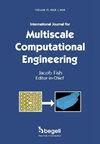循环加载下渗流特性CFD-DEM耦合模拟数值分析
IF 1.4
4区 工程技术
Q2 ENGINEERING, MULTIDISCIPLINARY
International Journal for Multiscale Computational Engineering
Pub Date : 2023-01-01
DOI:10.1615/intjmultcompeng.2023049894
引用次数: 0
摘要
循环荷载对土体的性质有重要影响,对岩土工程构成严重威胁。然而,循环荷载对间隙级配颗粒土渗流的影响目前尚不清楚。本文采用计算流体力学(CFD)和离散元法(DEM)的耦合方法,即CFD-DEM耦合方法,对三轴压缩下土样的渗流进行了系统的数值模拟。该方法能够模拟循环荷载作用下裂隙级配土的渗流过程,揭示流体场的演化过程。裂隙级配土样的渗透是通过施加向下的渗流来实现的。结果表明,与固定外力作用下的模拟相比,循环加载在扩散过程中产生了更大的侵蚀质量和流体速度。侵蚀曲线可分为两个阶段。在第一阶段,颗粒损失率高,但只持续很短的时间。然后,颗粒损失率减慢,进入第二阶段。在这一阶段,与非振动试样相比,循环加载的试样仍然存在较大的侵蚀质量,这种侵蚀质量一直持续到模拟结束。灵敏度分析表明,第一阶段的扩散对振幅的增加更为敏感,而第二阶段的扩散对频率的增加更为敏感。本文章由计算机程序翻译,如有差异,请以英文原文为准。
Numerical analysis of suffusion behavior under cyclic loading with coupled CFD-DEM simulation
Cyclic loading has a significant effect on soil properties and seriously threatens geotechnical engineering. However, the influence of cyclic loading on the suffusion in gap-graded granular soils remains unclear up to now. In this study, systematical numerical simulations of suffusion in soil samples subjected to triaxial compression are performed with the coupled computational fluid dynamics (CFD) and discrete element method (DEM) approach, i.e., the coupled CFD-DEM. The method is able to simulate the suffusion process in gap-graded soils under cyclic loading and reveal the evolution of fluid fields. The suffusion of gap-graded soil sample is achieved by imposing a downward seepage flow. The results indicate that, cyclic loading induces greater erosion mass and fluid velocity during the suffusion process, as compared to simulations under fixed external forces. The erosion curve can be divided into two stages. In the first stage, the particle loss rate is high but it only lasts for a very short of time. Then, the particle loss rate slows down and enters the second stage. In this stage, compared to the non-vibration sample, the sample subjected to cyclic loading still has a large eroded mass, which persists until the end of the simulation. The sensitivity analysis indicates that the first stage of suffusion is more sensitive to an increase in vibration amplitude, whereas the second stage is more responsive to an increase in frequency.
求助全文
通过发布文献求助,成功后即可免费获取论文全文。
去求助
来源期刊
CiteScore
3.40
自引率
14.30%
发文量
44
审稿时长
>12 weeks
期刊介绍:
The aim of the journal is to advance the research and practice in diverse areas of Multiscale Computational Science and Engineering. The journal will publish original papers and educational articles of general value to the field that will bridge the gap between modeling, simulation and design of products based on multiscale principles. The scope of the journal includes papers concerned with bridging of physical scales, ranging from the atomic level to full scale products and problems involving multiple physical processes interacting at multiple spatial and temporal scales. The emerging areas of computational nanotechnology and computational biotechnology and computational energy sciences are of particular interest to the journal. The journal is intended to be of interest and use to researchers and practitioners in academic, governmental and industrial communities.

 求助内容:
求助内容: 应助结果提醒方式:
应助结果提醒方式:


